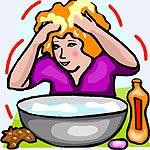31 Reflexive Verbs
Reflexive Verbs
Grammar A
Reflexive verbs differ from other verbs in that the doer of the action and the receiver of the action are the same person. Reflexive verbs are often listed with the reflexive pronouns “se” attached to the infinitive: levantarse (to get up).
Forms of the reflexive verbs
Reflexive verbs always appear with the appropriate reflexive pronoun. It is important to understand that the reflexive pronoun functions as an object pronoun and does not take the place of the subject pronoun: (yo) me lavo, (tú) te lavas, and so on. The reflexive pronouns are given below:
|
|
singular |
plural |
||
|
1st person |
me |
(to) myself |
nos |
(to) ourselves |
|
2nd person |
te |
(to) yourself |
os |
(to) yourselves |
|
3rd person |
se |
(to) himself, herself etc. |
se |
(to) themselves etc. |
Study the example of a reflexive verb:
|
me levanto |
I get up |
nos levantamos |
we get up |
|
te levantas |
you get up |
os levantáis |
you-all get up |
|
se levanta |
he/she gets up, you get up |
se levantan |
they/you-all get up |
Position of reflexives
- Reflexive pronouns go immediately in front of conjugated verbs.
Me despierto. I wake up.
María se pone el vestido. Mary puts on the dress.
- If an infinitive or a present participle is involved, you can put the refelxive pronoun behind the infinitive or the present participle, or in front of the first verb.
Quiero ducharme. / Me quiero duchar.I want to have a shower.
Exercises A
Mi Rutina Diaria
 a a |
 b b |
 c c |
 d d |
 e e |
 f f |
 g g |
 h h |
 i i |
 j j |
 k k |
 l l |
Ej. 1a Empareja los dibujos con las palabras
| lavarse (el pelo) | despertarse (ie) |
afeitarse |
|
levantarse |
cepillarse/lavarse los dientes |
ducharse |
|
peinarse/cepillarse el pelo |
ponerse |
acostarse (ue) |
|
vestirse (i) |
quitarse |
bañarse |
Ej. 1b Escribe los verbos en la forma de “yo”. Ejemplo: llamarse → me llamo
Ej. 2 Completa las frases con los pronombres reflexivos apropiados.
-
- Yo ____ acuesto a las once.
- Juan ____ afeita cada mañana.
- María ____ quita el suéter.
- Nosotros ____ cepillamos los dientes.
- ¿Por qué no ____ peinas?
- Ellos ____ sientan a nuestra mesa.
- Aquel señor siempre ____ viste muy bien.
- ¿A qué hora ____ marchan ustedes?
- Yo ____ duermo en cuanto ____ acuesto.
- ¿A qué hora ____ despiertas? Ej. 3 Pon los verbos entre paréntesis en la forma correcta del presente.
- Yo siempre ______ (acostarse) temprano.
- Ella ______ (bañarse) cada mañana.
- La niña ______ (mirarse) en el espejo y ______ (peinarse).
- ¿Por qué no ______ (sentarse) tú con nosotros?
- Él ______ (vestirse) ahora para el baile.
- ¿Niño, por qué no ______ (lavarse) tú la cara?
- Nosotros ______ (cepillarse) los dientes.
- Nosotros nunca ______ (dormirse) en seguida.
- Ellos no ______ (despertarse) sin dificultad.
- Carlos ______ (ponerse) el traje nuevo.
Grammar B
Reflexive vs Non- refexive Verbs
- A reflexive verb sometimes differs in meaning from the nonreflexive form. Study the following examples:
|
divertir (ie) |
to amuse |
divertirse (ie) |
to amuse oneself, have a good time |
|
llamar |
to call |
llamarse |
to call oneself, to be called |
|
cepillar |
to brush |
cepillarse |
to brush (one’s teeth, one’s hair) |
|
vestir (i) |
to dress |
vestirse (i) |
to dress oneself, to get dressed |
|
lavar |
to wash |
lavarse |
to wash (oneself) |
|
levantar |
to lift, raise |
levantarse |
to get up |
|
peinar |
to comb |
peinarse |
to comb one’s hair |
|
afeitar |
to shave (someone) |
afeitarse |
to shave |
|
despertar (ie) |
to wake up (someone) |
despertarse (ie) |
to wake up |
|
duchar |
to shower someone |
ducharse |
to have a shower |
|
bañar |
to bathe someone |
bañarse |
to have a bath |
|
quedar |
to remain |
quedarse |
to stay |
|
acostar (ue) |
to put someone to bed |
acostarse (ue) |
to go to bed |
|
preparar |
to prepare |
prepararse |
to get ready |
|
sentar (ie) |
to seat |
sentarse (ie) |
to sit down |
|
sentir (ie) |
to regret |
sentirse (ie) |
to feel |
|
poner (pongo) |
to put |
ponerse (me pongo) |
to put on (clothing) |
|
despedir (i) a |
to fire |
despedirse (i) de |
to take leave, to say good-bye |
|
parecer |
to seem |
parecerse |
to look alike |
|
Nonreflexive |
Reflexive |
|
Lavo las manos de mi hermano. I wash my brother’s hands. |
Me lavo las manos. I wash my hands. |
|
La madre acuesta a los niños. The mother puts the children to bed. |
La madre se acuesta. The mother goes to bed. |
|
Pones el vaso en la mesa. You put the glass on the table. |
Te pones la corbata roja. You put on the red tie. |
- After a reflexive verb, the definite article (not the possessive, as in English) is used with articles of clothing and body parts.
Se pone el abrigo. He is putting on his coat.
Me lavo los dientes. I brush my teeth.
- The reflexive can be used to mean “to oneself”. The prepositional phrases a mí mismo, a ti mismo, a sí mismo etc. are optional and can be added for extra emphasis.
Yo me hablo (a mí mismo/a).I talk to myself.
Ellos se mienten (a sí mismos/as).They lie to themselves.
- The plural reflexive pronouns (nos, os, se) can be used to express mutual or reciprocal actions, generally expressed in English with the phrase each other. When context is not sufficient to establish meaning, the reciprocal is indicated by the clarifying phrase uno a otro (una a otra, unos a otros, unas a otras). The use of definite articles in the clarifying phrase is option: el uno al otro, la una a la otra.
Nos escribimos muy a menudo. We write to each other frequently.
Os veis con frecuencia, ¿no? You (all) see each other a lot, don’t you?
Van a hablarse uno a otro. They are going to talk to each other in the bar.
Grammar C
Other Uses of Reflexive Verbs
- The reflexive pronoun se can also be used with certain verbs to express the idea of get or become. Many of the verbs below that use reflexive pronouns are not reflexive, that is, they do not convey the idea of a subject performing an action on itself.
|
Physical Change |
|
Emotional or Mental Change |
|
|
cansarse |
to get tired |
alegrarse (de) |
to get happy (about) |
|
calentarse (ie) |
to get warm |
asustarse (de) |
to become frightened (of) |
|
dormirse (ue) |
to fall asleep |
casarse (con) |
to get married (to) |
|
enfriarse |
to get cold |
comprometerse (a) |
to make a commitment (to) |
|
levantarse |
to stand up |
divertirse (ie) |
to have a good time |
|
mojarse |
to get wet |
divorciarse (de) |
to divorce (from) |
|
secarse |
to become dry |
enamorarse (de) |
to fall in love (with) |
|
sentarse (ie) |
to sit down |
enfadarse (con) |
to get angry (with) |
|
convertirse (ie) en |
to convert to |
enojarse (con) |
to get angry (with) |
|
hacerse |
to become |
llevarse bien (con) |
to get along well (with) |
|
ponerse + adjetivo |
to become |
oponerse (a) |
to be opposed (to) |
|
|
|
preocuparse (de/por) |
to worry (about) |
|
|
|
quejarse (de) |
to complain (about) |
This use of reflexive pronouns to signal inner feelings or processes, especially changes in physical, emotion, or mental states or changes in position is very frequent in Spanish. In contrast to reflexive constructions, English does not have a special way to indicate a process. For example, in the phrases the water freezes and the snow melts, it is clear from the context that the water and the snow are not performing actions. Rather, each is undergoing a process, in this case a change in physical state. In Spanish, a process is always signalled by a reflexive pronoun.
El niño se enfermó. The child got sick.
Todos nos levantamos cuando entró. We all stood up when he entered.
Me puse furiosa al recibir las noticias. I got furious upon receiving the news.
- Because both reflexive and process constructions use the same set of pronouns, the two structures look very similar. In addition, many verbs can be used with both meanings.
Reflexive: El niño se secó después del baño. The child dried himself off after his bath.
Process: El café se seca al sol por varias semanas. The coffee dries (out) in the sun for several weeks.
Actually, the process use of se is much more common than the reflexive use. You may find that being aware of the process meaning can help you to interpret many constructions more accurately when context makes the reflexive meaning unlikely.
The verb to become
- ponerse + adjective = a (temporary) change in physical or emotional state
Se puso enfermo. He got (became) sick.
Se van a poner furiosos. They are going to get angry.
- volverse + adjective = a long-lasting, often irreversible change in physical or emotional state
Se volvió loco. He went (became) crazy. (He is now crazy)
El nuevo camarero se ha vuelto muy perezoso. The new waiter has turned very lazy. (He is now lazy).
- llegar a ser + noun/adj = to get to be, implying a slow transformation process, usually involving some kind of effort in the pursuit of a goal.
Llegó a ser una pintora famosa. She became a famous painter (in time).
Después de muchos años, llegó a ser rico. After many years, he became rich.
- hacerse + noun/adj = to become (general)
Se hizo socialista. He became a socialist.
Se hizo rico con la compraventa de coches. He became rich by buying and selling cars.
La situación se hizo (se puso) imposible. The situation became impossible.
Exercises B
Ej. 4 Escoge el verbo apropiado para cada frase.
- (Pongo / Me pongo) las rosas en la mesa.
- Siempre (pongo / me pongo) los calcetines primero.
- Los gemelos (parecen / se parecen) mucho.
- Eduardo (parece / se parece) cansado.
- Yo (parezco / me parezco) a mi madre.
- Alda (llama / se llama) a su novio.
- Los domingos (levantas / te levantas) a las diez.
- (Levanto / Me levanto) cinco kilos fácilmente.
- Siempre (acuesto / me acuesto) a los niños temprano.
- Mi marido y yo (acostamos / nos acostamos) tarde.
- Tú siempre (bañas / te bañas) con agua fría, ¿verdad?
- No (baño / me baño) al perro con mucha frecuencia.
Ej. 5 Traduce las siguientes frases al español.
- I come home to eat at nine.
- They go to bed at ten.
- Maite falls asleep immediately.
- You (singular) come back and do your homework.
- I go out at eight, then you (plural) get dressed.